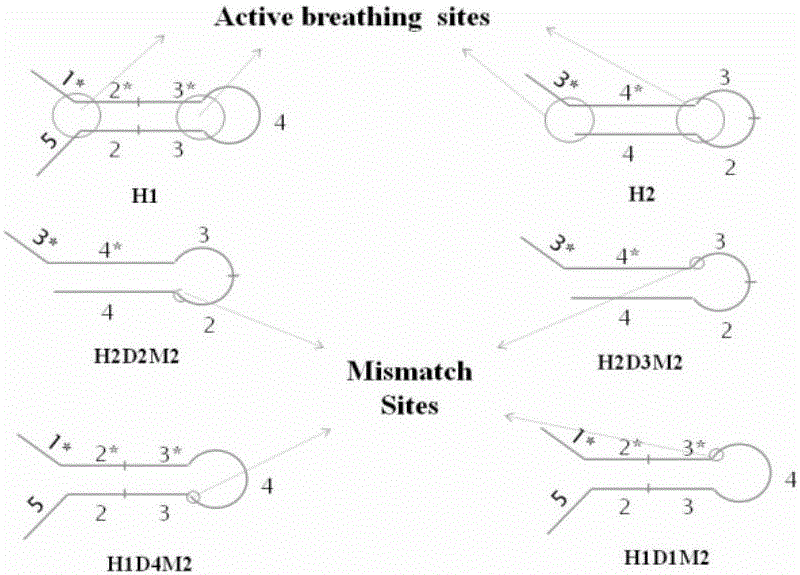A kind of electrochemical sensor and its preparation and application
A sensor and electrochemical technology, applied in the field of electrochemistry, can solve problems such as time-consuming, low throughput, and unsuitable for precise quantitative analysis
- Summary
- Abstract
- Description
- Claims
- Application Information
AI Technical Summary
Problems solved by technology
Method used
Image
Examples
Embodiment 1
[0101] Embodiment 1 prepares electrochemical sensor
[0102] 1. Materials and methods
[0103] 1.1 Materials
[0104] The sequences involved in the present invention are synthesized and purified at Shanghai Sangong, alkaline phosphatase-labeled streptavidin, 6-mercaptohexanol (MCH), bovine serum albumin (BSA), α-naphthyl phosphate ( α-NP) were purchased from Sigma-Aldrich, USA.
[0105] 1.2 Testing instruments
[0106] The CHI660D electrochemical workstation is a product of Shanghai Chenhua Instrument Company.
[0107] 1.3 Detection principle
[0108] Firstly, the capture probe for MicroRNA-21 is immobilized on the surface of the gold electrode by sulfhydryl groups to obtain the working electrode, and then the designed two stem-loops H1 and H2 and the target substance MicroRNA-21 to be detected are simultaneously added to the buffer for amplification After a period of time, the obtained amplified product was added dropwise to the working electrode, then alkaline phosphatase...
Embodiment 2
[0125] Characterization and inspection of the electrochemical sensor of embodiment 2
[0126] The electrochemical sensor obtained in embodiment 1 is characterized as follows:
[0127] 1. Electrochemical characterization of different modified electrodes
[0128] like figure 1 Shown is the square wave voltammetry response curve of different modified electrodes in 5mM potassium ferricyanide solution in each step:
[0129] a is a bare gold electrode;
[0130] b is the fixed capture probe;
[0131] c is the electrode sealed by MCH and BSA;
[0132] d is after adding the amplification product catalyzed by no target substance;
[0133] e is after adding the amplification product catalyzed by MicroRNA-21.
[0134] When the capture probe was immobilized on the surface of the bare gold electrode, the peak current decreased significantly ( figure 1 - Curve b), the result shows that the capture probe was successfully immobilized on the electrode. When MCH and BSA blocked the ele...
Embodiment 3
[0142] Embodiment 3 The optimization of electrochemical sensor and its service conditions
[0143] We also fixed several important conditions during the experiment, namely the number of base mismatches and H1 at 50nmol ml -1 The concentration of stem-loop H2, the temperature of the amplification system, and the reaction time of the amplification system were further optimized. For each condition, five points were selected from low concentration to high concentration to carry out a series of experiments.
[0144] In order to investigate the influence of base mismatch sites on electrochemical sensors, this experiment used stem-loops with different base mismatch sites (H1D1M2, H2D2M2, H2D3M2, H1D4M2), and then performed differential pulse voltammetry scanning. like image 3 , 4 It can be seen that the signal-to-noise ratio varies with different mismatched sites. When it is H2D2M2's turn, the signal-to-noise ratio reaches a maximum value of 33.6, which is higher than that of mis...
PUM
 Login to View More
Login to View More Abstract
Description
Claims
Application Information
 Login to View More
Login to View More - R&D
- Intellectual Property
- Life Sciences
- Materials
- Tech Scout
- Unparalleled Data Quality
- Higher Quality Content
- 60% Fewer Hallucinations
Browse by: Latest US Patents, China's latest patents, Technical Efficacy Thesaurus, Application Domain, Technology Topic, Popular Technical Reports.
© 2025 PatSnap. All rights reserved.Legal|Privacy policy|Modern Slavery Act Transparency Statement|Sitemap|About US| Contact US: help@patsnap.com



